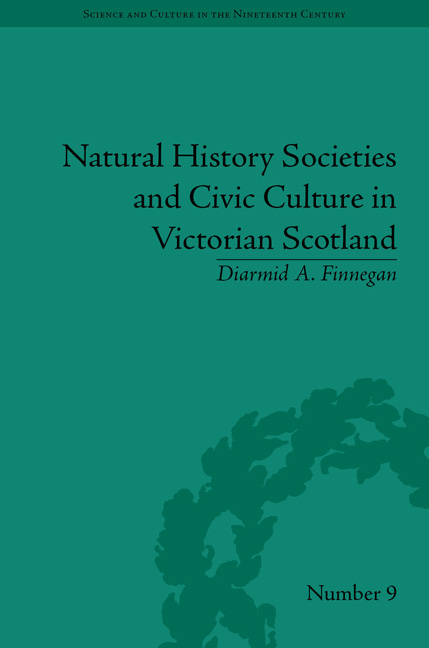Book contents
- Frontmatter
- CONTENTS
- Acknowledgements
- List of Figures and Tables
- Introduction
- 1 Founding Narratives
- 2 Fieldwork and Excursion Culture
- 3 Natural History and Civic Pride
- 4 Natural History and Self Culture
- 5 Organizing Subscriber Science
- 6 Scientific Motives and Civic Virtue
- Conclusion: Between Science and Civic Society
- Notes
- Works Cited
- Index
5 - Organizing Subscriber Science
- Frontmatter
- CONTENTS
- Acknowledgements
- List of Figures and Tables
- Introduction
- 1 Founding Narratives
- 2 Fieldwork and Excursion Culture
- 3 Natural History and Civic Pride
- 4 Natural History and Self Culture
- 5 Organizing Subscriber Science
- 6 Scientific Motives and Civic Virtue
- Conclusion: Between Science and Civic Society
- Notes
- Works Cited
- Index
Summary
Scottish natural history societies, situated in civic culture and orientated towards a local public, were also significantly shaped by connections with a wider scientific community. One ruling objective of the societies, to explore and catalogue local natural history, was of potential interest to a scientific as well as a local audience. In order to render such activities useful to science, certain procedures and lines of investigation were promoted to secure scientific credibility. The recommendation of certain methods and projects was supplemented by fostering links, formal and informal, with other scientific bodies and by creating a library of scientific texts to keep pace with wider developments. Such links in terms of strength, number and duration varied from society to society and in ways connected with, but also distinct from, the relations between naturalists’ associations and local civic society. This chapter examines the ways in which the societies managed their self-styled scientific transactions. Particular attention is given to the basic organizational features that connected the societies to a wider scientific world, and to the published output of members who were particularly concerned with their society's scientific reputation.
The chapter is divided into four parts. The first deals with the relationship between Scottish natural history societies and emerging scientific specialisms. This discloses something of the geography of disciplinary affinity as manifested by the scientific activities of society members. The section demonstrates that local contingencies and individual interests meant the scientific pursuits of society members tended to cluster around certain specialisms. Before 1883, for example, the Natural History Society of Glasgow was an important centre for Scottish ornithology. Examining these dominant interests in the light of wider disciplinary contexts situates further the scientific ambitions of the societies in the world of mid- to late Victorian scientific endeavour. Part two examines informal links set up between societies and other scientific constituencies.
- Type
- Chapter
- Information
- Publisher: Pickering & ChattoFirst published in: 2014

